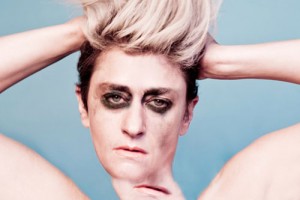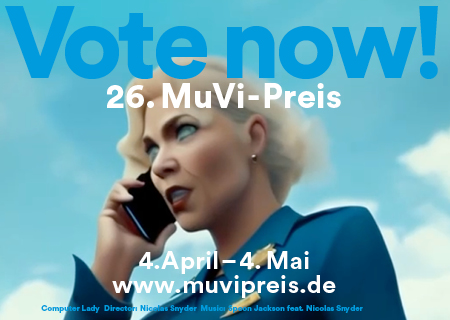Loretta Fahrenholz: “I like it when films cause vertigo”
Beforhand, I should note, that I only saw the vide for “Sketch Artist” after I had already known those for “Paprika Pony” and “Don’t Play It Back”, as it does of course influence my view of all the works. You succeed extremely well in capturing this whirling feeling that Kim Gordon transports in the song and throughout the album with the video clip for “Sketch Artist”. To quote the poetic line of the song: „Sketch your heart and stop /Sketch your heart and stop / And the wind chimes strike / Your dead stare strikes.“
Los Angeles shines in your images, the characters sparkle extravagantly and seem so full of life, but of course everything breaks two and three times, real due to the tent cities downtown, constructed due to the hipsters falling down incessantly, struck by the glances of the “under” driver Kim Gordon or frozen in Fellini-esk Oversexualization.
The pseudo-sociality of this new world stands out from every attitude – right at the beginning, brought up by the question “Water? Charger? Music” from the “Under”-driver to her passengers. More pseudo care is not possible. And then, on the contrary, the driver is suddenly alone in the car, an attitude of brutal directness: lonely among people.
My question: How difficult was it for you to stage all this dreariness, which is being dealt with here, so aesthetically?
I would say the real conditions are much more brutal than any kind of representation of them. In films about LA there is often a lot of retouching going on, but the social and technological clash in the city is very present. Also the question, who is dominating whom. What does it look like, when the roles of player/protagonist/consumer and product implode? To me this emotional, social and digital disorientation runs like a thread through “No Home Record”.
Do you think that the picture of Los Angeles in the video clip, but also in the ones that are following now, corresponds with the image of the city that Kim Gordon paints on “No Home Record”?
I guess that wasn’t my claim in the first place. I prefer to work somewhat non-intentional, more in the moment. I also have Tarkovsky in the back of my mind, who advocated for a separation of sound and image. Both should have their own presence without illustrating each other. When you look at cinema or TV this is actually very rarely the case.
In the past, you have always referred to artists such as New York writer Kathy Acker, French ethnologist and filmmaker Jean Rouchs or the auteur Robert Altman in your works. Would you argue there are similarities in the way you perceive their material and bring it into your own work with the more direct process of exchange that you have now with Kim Gordon?
Of course it’s a big advantage being able to talk in person. But I also like misunderstandings. I don’t think you have to fully understand something to being able to react to it.

“Paprika Pony“ (Still by Loretta Fahrenholz)
So far, apart from the video for “Sketch Artist”, the videos for “Paprika Pony”, which we are presenting today, and “Don’t Play It Back” (which we will premiere on Kaput next week) are finished.
What I really like about “Paprika Pony” is this idiosyncratic mixture of “moving images”, sometimes the wind is natural, sometimes it is artificial, sometimes man lets the world rotate, sometimes technology lets people rotate, and of course the camera moves again and again. And in the end you can’t tell up from down, or true from fakse.
Is this confusion intended and desired?
Yes. I like it when films cause vertigo. I think this is also a specific decision for postcinema.
“Dont Play It”, on the other hand, is visually much more direct in its design. “Give me all you have” is depicted with water fountains and receiving hands and requests to pee are accompanied by the Eiffel Tower and tilted pictures – and suddenly Kim Gordon is sitting in front of us, as alive as a figure from Luchino Visconti’s “Death in Venice”, and not even the US flag can get a reaction from her. This is a comical break, as Kim Gordon cultivates a very ethnological view of her old/new hometown Los Angeles on the album, as is clearly shown in the video for “Sketch Artist”. Is the breaking in this video also a reaction to the other video? Or do you perhaps not even perceive it in this way?
Hmm, maybe not. We are still in public space and the gestures are quite elusive, freezing just for a moment.

„Dont Play It“ (Still by Loretta Fahrenholz)
What unites “Paprika Pony” and “Dont Play It”, is that they develop their narrative from the totality of the images. Which may sound like a statement with zero value at first. By that, I mean that there is no classical leitmotif as in “Sketch Artist”, but the story that is conveyed, results from the rythm of the individual motifs that you construct but that the recipient perhaps perceives in a completely different way. In the extreme form in”Paprika Pony”, but despite the presence of Kim Gordon in the video for “Don’t Play It Back”, in a way, also in that, in that sense,, the clip as work is bigger than the protagonist. Since the question is missing so far: Would you agree with me?
To me “No Home Record” is a kind of sonic image of LA, so it made sense to give LA some space as a character in the videos.
Maybe you would like to say something about your different working methods: For “Sketch Artist” you were able to work with a budget and film especially for it and the other works are all outtakes or other takes?
Yes, I shot them along the way while working on Sketch Artist. A lack of attention to something can sometimes be really helpful, you have to trust your immediate perception more.
Over the last few years I was working on a feature film about surveillance, i think without noticing I started to adapt the view of a surveillance camera, constantly observing movements and actions in public space.

“Sketch Artist” (Still by Loretta Fahrenholz)
Loretta, for which songs will there also be videos, if I may ask?
“Earthquake”, “Murdered Out” and “Hungry Baby”.
Last question: What did you recently delete? Of course, I’m asking this in reference to your 2017 book with the great title “Recently Deleted”, published in collaboration with Bill Hayden.
A still life. Blurred carrots on a red table.
Translation by Denise Oemcke.














